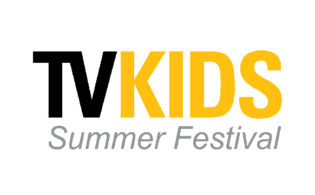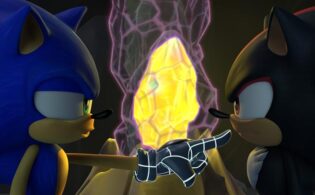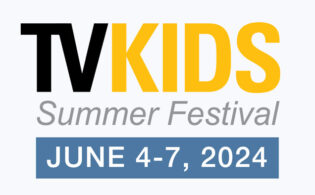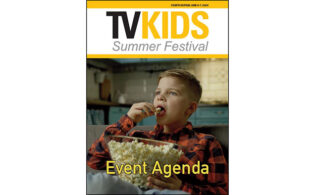Paramount’s Layla Lewis, POP Channels’ Francesca Newington, Sensical’s Bethany Boles and De Agostini Editore’s Brenda Maffuchi shared their acquisition wish lists and discussed increasingly complex rights negotiations as the TV Kids Summer Festival kicked off today.
The lively discussion, excerpted below and available to view in its entirety here, was moderated by Kristin Brzoznowski, the executive editor of TV Kids.
Acquisitions and other content partnerships play a key role for all the platforms represented at the session, including Paramount Global. Lewis, senior VP of global acquisitions and content partnerships for Nickelodeon, noted, “We look to complement and be additive to our original slate and have acquisitions and content partnerships that reach that audience across all of our platforms and be a significant part of our offering. We look at how we can manage and window across those platforms to create this strategic approach to a launch.”
At De Agostini Editore, about 60 percent of the slate across its portfolio—including pay-TV channels and an on-demand service—is acquired, according to Maffuchi, head of acquisitions and property development.
Sensical, meanwhile, the AVOD service operated by Common Sense Networks, is entirely acquisitions-based. Boles, head of programming, noted, “We hope to have original programming at some point down the line, but right now, we’re all about the volume game, so acquisitions are everything to us. We are sourcing content from traditional studios and distributors and working directly with digital-first creators from all over the web, mostly from YouTube.”
Newington, director of POP Channels at Narrative Entertainment, programs Pop, Tiny Pop and Pop Max. “Acquisitions for us have always been super important,” she stated. “They’ve been 95 percent to 100 percent of our content. We are trying to do more prebuys where possible so that we can broaden our rights and also so that we can plan future strategy a little bit better. And we are also now diving into the world of co-pros and commissions. We’re going to take it step by step, but we would welcome any submissions to us in that space. We also have our AVOD offering, the Pop Player, which incorporates catch-up content. And for that, we are looking to introduce exclusive content that doesn’t feature on the linear channels.”
Each programmer then articulated the unique set of brand filters they keep in mind when acquiring new content. For Maffuchi, “character-driven” shows are paramount. “Friendship and diversity are two things that we’re constantly looking at. We are not 100 percent educational, so entertainment is important in terms of the balance.” And her approach is also constantly evolving, Maffuchi said. “We follow the trends of the market. As long as it is kids and family content, we will evaluate it.”
Sensical, meanwhile, takes its cues from being affiliated with Common Sense Media. “All of our content is filtered through the world’s only age-appropriate content standards, grounded in child development and developed by experts from Common Sense Media over the last 20 years,” Boles said. “We borrow heavily from what Common Sense Media is doing. We’re all about filtering for age appropriateness,” with the platform’s content segmented by demo: 2 to 4, 5 to 7 and then 8-plus.
Given the breadth of Paramount’s offer for kids across multiple platforms, “You have to have these characters that resonate with the audience in all of those touchpoints,” Lewis explained. “Nickelodeon has always stood for the celebration of being a kid and understanding what it means to be a kid. So having that filter of a kid’s point of view is important for us.”
Newington stressed that as the Pop channels are free to air: “We have a broad socio-economic audience. We’re keen for our channels to be all about diversity and broad representation. We want [audiences] to feel that the channels are genuinely inclusive and reflective of them. We are super commercial. We want to remain current. Volume is very important, so 26 half-hours minimum.” Pop targets kids 6 to 10, while Tiny Pop is for the upper preschool end of 4 to 6. “Anything too slow-paced or too young would be not right for Tiny Pop, and anything with imitable behavior. Anything all-out educational is quite hard for us to schedule.” At Pop, meanwhile, Newington is always on the lookout for shows with “comedy, pace, adventure.”
As for content wish lists going forward, Boles has her eye on shows that will key into an older kid demo. “I think we all know how hard it is to keep kids watching kids’ TV. Finding compelling content for the older kids is always important to us. In that older bracket, gaming content is crushing it. So we’re looking for more age-appropriate gaming content—that’s the tricky part. We’re looking for content across all ages that leans into what we call watch and do: cooking, arts and crafts, science experiments, things that kids can explore and hopefully want to go off and try, maybe even as a family. And give us all the Minecraft, give us all the Roblox, just bring it on!”
Lewis noted the breadth of demos served by Nick’s platforms and added that she and her teams are mainly looking for content for 2024 and beyond. “The short-term acquisition space is filled at the moment, certainly for this year. We do like to get involved early.”
Newington has her eye on gender-neutral shows for the 6-to-8 set on Pop. “If we take something very girly, we need to make sure that we’ve got something for the boys as well,” she said. “We’re pretty much animation, but we are looking into that live-action space—either a drama or factual-entertainment, as long as it’s upbeat and pacy enough, and it’s not too old, dark or scary.” On Tiny Pop, the wish is also for shows that will speak to boys and girls, again mostly animated, but she isn’t ruling out live action. “We haven’t seen anything musical for a while, so any musical content would be lovely,” she added. “We’re looking for movies, too. We’d like to build up a movie inventory for special themes: Christmas, October, half-term, Halloween.”
Maffuchi said she and her teams continue to seek out big animated franchises for preschoolers at De Agostini. Like Newington, she is also eyeing gender-neutral shows for the 6-plus set, noting this becomes increasingly difficult for the upper end of the kids’ target. “The thing that we will be missing the most, even for this year—although we’re working on 2023 and 2024—are good animated comedies for 6 to 11s. It’s really hard to find good comedy that will immediately engage with that target.” In terms of live-action, she is seeking content for the 8-to-10 set and possibly even reaching up to 13- and 14-year-olds. “We have the linear channels and the VOD platform. So, it’s not only the content but also all the content that we can build around the IP to try to connect as much as possible with the kids on all the different platforms. From 9 to 12, it’s really difficult to keep them engaged as much as we would like to. This is what we’re trying to work on. We will be producing local game shows or entertainment formats for the target, with family co-viewing. This is something we are working on for 2023.”
As for what’s missing from the market, the panelists highlighted diverse and inclusive content. “We talk about wanting every kid to be able to see themselves in our content,” Boles said. “That includes diversity in its many forms. We are seeking out content that’s not only featuring diverse characters but also made by diverse creators. We are struggling to find content by Latinx creators and featuring Latinx characters. We want content from creators of all backgrounds.”
Going beyond just visual representation is critical, Lewis agreed. “If we’re on board with a content partnership, we work with the companies to help with that and draw on some of [our] resources. Certainly, in the linear space, our audience has gotten younger. To hold on to that upper end of the demographic is tough. To have the sophistication in the writing and everything you need in broad comedy, gender-neutral, for 6 to 11, is a challenge. But we’re always interested in seeing those ideas and things that surprise us—things that feel irresistible.”
Newington identified girl-led comedies for the 6-to-8 set as a significant gap in the market. “It needs to be where the female gets the laughs rather than the tokenistic joke. We want the girl to have her time in the spotlight. And for that content not to turn off the boys but actually to appeal to them too.” She’s also seeking out anime that is appropriate for the Pop demo. “It’s very difficult to pick up anime that isn’t slightly too grown-up or risqué. Anime historically has worked quite well on Pop. It’s tricky when you’re going through compliance not to edit everything out. And then you’re left with the bare bones and not very much story! It would be fantastic to find something that was aimed at 8-year-olds, without the concern that we would have to rip it apart in the compliance edit.”
She’s also keen to find a “laugh-out-loud comedy” for preschoolers that will entertain parents and older siblings. “Everybody can watch it and feel like they’re having a great time. And that will spark the parental trust that we’re after. That co-viewing is so important for Tiny Pop.”
Lastly, Newington would love to see shows that “genuinely incorporate” environmental themes, “rather than being crowbarred in there.”
The conversation then moved to rights negotiations and the importance of exclusivity. For De Agostini in the pay-TV space, exclusivity is key, Maffuchi noted. “The only thing we can have non-exclusively is VOD rights. Holdbacks are still quite important for us. Depending on the case, we will have between 6 to 12 months of exclusivity for the content. We still have space for content that is not European, but the obligation, the percentage we need to cover, is getting higher.”
“Exclusivity and windowing are very important when we look at the linear side and what we’re trying to achieve with Paramount+,” concurred Lewis. “We want to reach our audience everywhere they are. If you have a broader scope of rights, you can work to meet them there. That’s not always the opportunity. When we have the pitch at an early stage, we can discuss that with the partner to say, what is the opportunity? How best can we navigate through the platforms and the rights? As everything has shifted and the proliferation of platforms continues, we try to think about what’s best for both of us in terms of our partnership.”
Newington believes that the market is at a “pivotal point” when it comes to the question of exclusivity. “We are aware that cross-pollination is really important when it comes to the brand getting as many eyeballs as it possibly can. If you’re going to launch a commercial franchise, you want to be across as many platforms as you can. It seems that it isn’t that detrimental to each platform that it is on—it seems to be successful for each one. So I think there’s quite a large conversation to be had around this.”
Newington added that the Pop channels will often take a second window on shows that previously aired on a pay-TV or SVOD service. “The issue there for us is that we get such limitations on digital rights. If we reject those limitations, that is detrimental to us because we lose that show, but it’s also not helpful to the commissioner who wants eyeballs on that brand and who wants to launch consumer products. It’s about navigating those restrictions and whether we can deal with them. It is becoming increasingly difficult to comply with five episodes only [on-demand] and no more than that at any one time. If we want to increase our digital offering, we’re going to need to be brutal and reject content that we would love to have.”
Boles noted that Sensical is focused on volume, not exclusivity. “We are certainly looking to make deals that allow us rights for our growing products. As we grow as a company, we’re thinking about worldwide, expanding with different FAST partners potentially. Those are the kinds of rights that we’re trying to work into our deals going forward. When we get to the point where we’re ready to have those conversations about exclusivity, it’ll be data-driven. We’re just not quite there yet.”
The panel wrapped with the programmers offering advice to IP owners keen to get their shows onto these services.
“Ancillary rights are very important,” Newington said. “So anything additional they can offer us—games, digital assets, music videos, short-form content—will help us launch the brand better. Volume is very important. It’s important to know that Tiny Pop isn’t for very young kids. It has to have a really good narrative. It’s got to be engaging. Kids at the age of four are very discerning, and they know a good story when they see one. Paying attention to the storyline is very important for those younger viewers, even though sometimes people might not think it’s that important. I would say bridge shows are quite hard for us to schedule. We can’t find a good space for them on our channels because they fall down that gap between Tiny Pop and Pop, and they don’t quite fit as well on either channel.”
Boles asked distributors to “have a clear audience in mind. Having a clear idea of where you think your content fits within one or more of [our] age brackets is helpful for us. We want to make sure that the content demonstrates benefits, whether learning benefits or D&I or social-emotional character-building elements. And then content that focuses on topics that kids love. So whether it is instructional—cooking, arts and crafts, sports tutorials—or more topic-based like travel or sports or music, we want to give kids what they want and do it in an age-appropriate way.”
Lewis called on producers to spend time watching Nickelodeon, Nick Jr. and Paramount+. “It’s just being aware of the shows we have and how anything will sit among them. We don’t want to get into a situation of, what do you do with it? We have seen a lot of pitches in the bridge space and we do now have quite a lot of shows in that area. We’re looking to complement that and maybe focus more on the younger end of the preschool demo. Another point that’s come up is around ancillary. We have within Paramount other lines of business. We can leverage those in terms of our content partnerships and co-productions to look at how we can partner with our in-house CP teams. We also have a movie studio. We are looking at exploring opportunities quite far out now. Know the audience and think about them in everything that you do. Know our shows and some of those brand filters. And have fun and surprise us.”
Maffuchi expressed a similar sentiment, noting, “We appreciate it when we are having a meeting with someone and they show us that they have studied. They know who we are and say, We think this could fit with this program. We appreciate it when someone has taken the time to look into our DNA.”
 TVKIDS
TVKIDS






